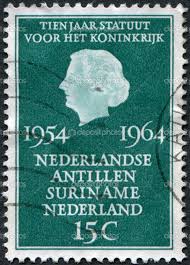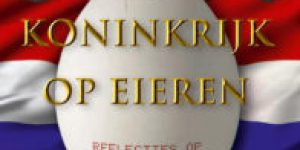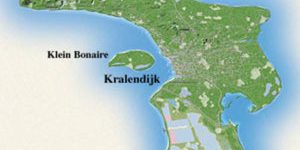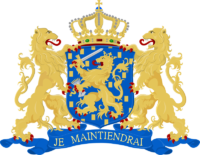The Kingdom Of The Netherlands In The Caribbean ~ Introduction
No comments yet This book occupies a special place among the numerous publications and events marking the 50th anniversary of the Charter for the Kingdom of the Netherlands. It is critical, steers clear of platitudes, and opens up new prospects: rather than losing themselves in reminiscences, the writers set out to define the tasks that lie ahead. Repairing the Kingdom, globalization, imagination, reforming and reinventing the Kingdom of the Netherlands – those are the watchwords – linking the contributions to this book. Without losing sight of historical realities (including the distressing fortunes of Suriname) the writers are more concerned – strikingly so – with the future. And they naturally avoid fixing their gaze narrowly on the islands themselves; instead, they take in the ocean that washes their shores, as it were – an ocean that links them to continents near and far and that has in a sense given the Caribbean island communities their open identity. Any comparison of the relative prosperity and well-being of the islands in the Caribbean demonstrates that those in a constitutional relationship with a larger country overseas are doing far better than the independent island states.
This book occupies a special place among the numerous publications and events marking the 50th anniversary of the Charter for the Kingdom of the Netherlands. It is critical, steers clear of platitudes, and opens up new prospects: rather than losing themselves in reminiscences, the writers set out to define the tasks that lie ahead. Repairing the Kingdom, globalization, imagination, reforming and reinventing the Kingdom of the Netherlands – those are the watchwords – linking the contributions to this book. Without losing sight of historical realities (including the distressing fortunes of Suriname) the writers are more concerned – strikingly so – with the future. And they naturally avoid fixing their gaze narrowly on the islands themselves; instead, they take in the ocean that washes their shores, as it were – an ocean that links them to continents near and far and that has in a sense given the Caribbean island communities their open identity. Any comparison of the relative prosperity and well-being of the islands in the Caribbean demonstrates that those in a constitutional relationship with a larger country overseas are doing far better than the independent island states.
Autonomy as watchword
Even so, during the period in which the Kingdom Charter came into being, the primary aim was to maximize the autonomy of the Netherlands Antilles and of Suriname – which at that point had yet to achieve independence. Until 1955 the Kingdom of the Netherlands found itself under heavy pressure in the United Nations to comply with its obligation to decolonize. At the end of that year, exactly twelve months after the signing of the Charter, the Kingdom’s reporting obligation was lifted, in recognition of the decolonization of Suriname and the Netherlands Antilles.[i] In this context, it makes perfect sense that the Charter was seen first and foremost as a document enshrining the autonomy of these territories. The enumeration of Kingdom affairs was construed as exhaustive, although scope was created for adding policy areas in mutual agreement, and for regulating certain matters jointly in Kingdom acts. The Charter also provides a broad framework for statutory or voluntary cooperation in arranging matters that, in principle, fall within the scope of the autonomy of the three countries of the Kingdom. This made the Kingdom of the Netherlands into an asymmetrical federal state, one of whose constituent parts or ‘countries’ – the Netherlands – accounted, and still accounts for the vast majority of the Kingdom’s population, its economic potential, and its institutional structure. In spite of this disparity, the equality of the Netherlands Antilles, Suriname (until 1975) and Aruba (since 1986) as other countries of this Kingdom is engraved in stone in the Charter.
A changed world
Fifty years on, the Charter remains almost unchanged but the world about it has been transformed. A world of separate national societies divided by heavily guarded borders in which independence was cherished as the highest ideal has given way to an acknowledged interdependence among states, from the largest to the smallest. This new pattern of international relations is still evolving. The old system of sovereign states as the supreme political structures ‘cannot cope’ with numerous transnational problems, some concerning garden-variety crimes (transnational mafias and cybercrime) and many concerning non-security related issues (environmental degradation and pandemics that know no borders).[ii] But new modes of international governance are still in development.
One of the most noteworthy changes is in the relationship between people and the multiplicity of dimensions of their everyday world. The formation of nation states was the result of a process of demarcation that involved not just the state and its laws but also the people subject to them. The 1950s witnessed, on the one hand, the formation of national states taking the place of colonial administration, and on the other, the first efforts to transcend states – preoccupation with borders which was often rooted in hostility – for instance, the founding of the European Communities.[iii] The Charter exhibits traces of both these trends: on the one hand, the autonomy it grants to the overseas territories appears to be a giant leap towards independence; on the other hand, the decision to link the three countries in an enduring confederation indicates that separatism is not necessarily the overriding force. A year before the Charter’s adoption, the Dutch Constitution had been amended to permit the transfer of certain powers to international agencies and to accord priority to applicable legal norms originating in the international arena.
Much has changed in the world since then, but the Charter – at least as far as its main features are concerned – has not. The tug-of-war between opposing forces that was going on when it was concluded continues to be felt today.
Take migration, one of the most obvious examples. The Charter and the relevant country ordinances are all based on the assumption that every person has a country to which he or she has an exclusive connection, whether by nationality or by residence. Moving from one territory to another is regarded, in principle, as a permanent change. Migrants are seen as people seeking a new homeland; the reintroduction of the requirement to renounce their previous nationality if they wish to become Dutch citizens amounts to an explicit assumption that they will put the past behind them, and the same applies in principle to migration within the Kingdom. The reality at the beginning of the twenty-first century, however, is that the desire for cross-border mobility – with frequent visits to the country of origin, which retains its practical and emotional significance – is more prevalent than a desire to emigrate for good.[iv] Neither policy nor legislation is attuned to this; on the contrary, the illusion is fostered on both sides, through admission regulations, integration conditions and language rules, that people can only be at home in one country. This means that a major opportunity, namely the option of a transatlantic Kingdom with shared nationality, is being missed. Were this principle to be embraced, policy in all the countries of the Kingdom would have to focus far more on educating people in cross-border citizenship, including matters such as language skills and historical awareness.
The Kingdom of the Netherlands and the European Union
A far more open approach to identity has been adopted in the development of the European Union. Even before the Treaty establishing a Constitution for Europe was drafted, a constitutional structure evolved from within the European Communities, for which the European Union, since the 1992 Maastricht Treaty, has provided the framework. The European part of the Kingdom of the Netherlands is fully integrated into it. On an equal footing with larger European states, including the United Kingdom, Germany, France and Spain, as well as small and even tiny states, the Netherlands accepts the fact that its legislation and policy are embedded in European laws, framework laws and other legislation. The Netherlands Antilles and Aruba have remained outside this structure to date, however, since these parts of the Kingdom are linked to the EU only as two of the – overseas countries and territories – associated with the EU. This association, which primarily facilitates exports of raw materials to Europe, meant a great deal to France’s colonies in Africa when the European Economic Community was first formed. Today, aside from the Caribbean parts of the Kingdom, it applies almost exclusively to sparsely or very sparsely populated islands that appear untouched by the thickening of international relations. For the Netherlands Antilles and Aruba, however, continued participation in the interplay of cross-border relations is of vital importance.
The ultimate effect of this differential relationship with the European Union is that, while the Netherlands becomes ever more firmly embedded in European structures, the ties within the Kingdom are being eroded.[v] The direct enforceability of judicial decisions in all member states does not apply to the overseas countries of the Kingdom. There are economic consequences as well in that the Netherlands Antilles and Aruba cannot benefit from key instruments of cross-border cooperation within and with the European Union, such as the external trade agreements concluded in the WTO and those with other economic alliances (e.g. Mercosur).
This situation need not continue. The Constitution for Europe provides the possibility of a special kind of affiliation to the European Union on the same basis as islands and island groups such as Guadeloupe, Martinique, Madeira, the Azores and the Canary Islands, known as the EU’s ‘outermost regions’. The debate on whether the Caribbean parts of the Kingdom should exploit this option is being distorted by those who see the application of European Union law solely in terms of a loss of autonomy. This is the same one-sided view that has muddied the waters of debate on the Constitution for Europe, and it reflects a lack of understanding of Union law and the way it works. This law is not aimed, nor could it be aimed, at eradicating the variety of socioeconomic, physical and geographical conditions in an enormously diverse area. What it does set out to achieve is the joint promotion of interests in the many areas (trade, social security, environment, food security, law enforcement, immigration and defence) in which countries – even much larger islands such as Ireland and Britain – can no longer act effectively in splendid isolation.
The Charter as a defining boundary
In the European part of the Kingdom too, most politicians have been far too slow to acknowledge that the existing weak form of association as ‘overseas countries and territories’ is slowly but surely undermining the ties within the Kingdom. This problem is exacerbated by the fact that the lonely path followed by the Netherlands Antilles and Aruba – aside from the association they have entered into with the far poorer independent states in the Caribbean – reinforces an introverted political culture. The Charter, at least as it has been interpreted in the past, is partly to blame for this. Because of the text’s emphasis on autonomy, the scope for cooperation the Charter provides has not been fully exploited.
While more and more opportunities for cooperation were being developed within the European Communities, the Netherlands Antilles and Aruba were trying to deal with a growing number of issues on their own. Even in areas of transport and communication – in which international cooperation is constantly expanding – separate companies have been set up in the Caribbean parts of the Kingdom, and these are often kept in operation against the island communities’ own interests. While countries such as France and Germany have relinquished monetary autonomy, giving up the franc and the mark for the euro, Aruba and the Netherlands Antilles each have their own currency.
Because of this one-sided emphasis on autonomy, the Charter has often been used as an argument for saying ‘no’, for instance with reference to the division of powers, even though the Charter incorporates many possible ways of saying ‘yes’. While the division of powers was intended to prevent clashes, it actually fostered a combative relationship. Article 43, para. 2 of the Charter (‘The safeguarding of such rights and freedoms, legal certainty and good governance shall be a Kingdom affair’), for instance, has often been interpreted as according powers to intervene. What was overlooked is that ‘safeguarding’ starts with preventive measures and quality assurance in public administration.
Solidarity as watchword
It is time to expand the definition of ‘Kingdom relations’ beyond the narrow context of the Kingdom, and to take advantage of them in perspective of the larger network of domestic and international relations. The opposite trends of the early 1950s are still making themselves felt today. The Treaty establishing the European Coal and Steel Community (ECSC) did not survive its 50th anniversary, while the Charter for the Kingdom of the Netherlands has reached that milestone basically unchanged. But that does not necessarily demonstrate the Charter’s greater vitality. On the contrary, the fact that the Charter has in no way been adjusted in response to modern developments is in itself an ambivalent sign. Is that because it was not necessary, or because too many were unwilling to let go of the status quo?
If solidarity rather than autonomy is taken as point of departure, new prospects present themselves. The one-sided fixation on relations within the Kingdom restricts the options and leads to greater dependence, while operating in networks would open the door to WTO, Mercosur, Caricom and the EU. Whether the authors of this book are looking back or looking ahead, they do not see the islands as separate planets or their beaches as the horizon. Taking a wider view of the past and present opens up new prospects for the future.
NOTES
i. See Gert Oostindie and Inge Klinkers, Knellende Koninkrijksbanden, Het Nederlandse dekolonisatiebeleid in de Caraïben, 1940-2000, vol. I, 1940-1954, Amsterdam: Amsterdam University Press 2001, p. 131.
ii. Amitai Etzioni, From Empire to Community: A New Approach to International Relations, New York: Palgrave Macmillan 2004, p. 143.
iii. Ernst M.H. Hirsch Ballin, The European Constitution of the Netherlands: Reflections on Interdependent Statehood, in Acta Politica, International Journal of Political Science, vol. 33, Autumn 1998, pp. 281-299.
iv. Relations between the Caribbean parts of the Kingdom and the Netherlands, and indeed between Morocco and the Netherlands, exhibit many similarities to those between Puerto Rico and the United States, as described by Jorge Duany in The Puerto Rican Nation on the Move, Identities on the Island and in the United States, Chapel Hill / London: University of North Carolina Press 2002.
v. Verdieping of geleidelijk uiteengaan? De relaties binnen het Koninkrijk en met de Europese Unie, Explanatory report of 9 September 2003 pursuant to section 18, subsection 2 of the Council of State Act, The Hague: Council of State 2004.
You May Also Like
Comments
Leave a Reply








